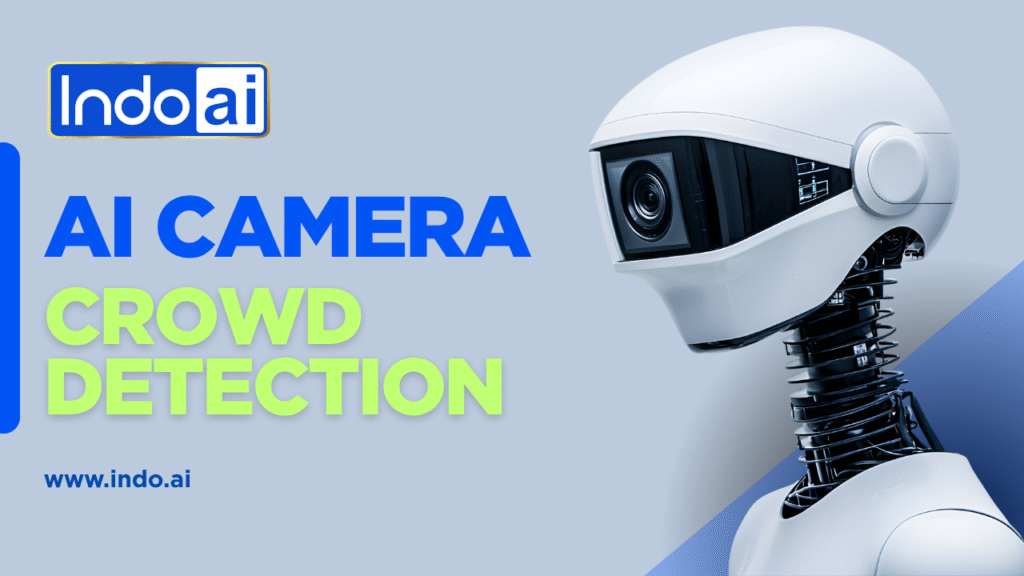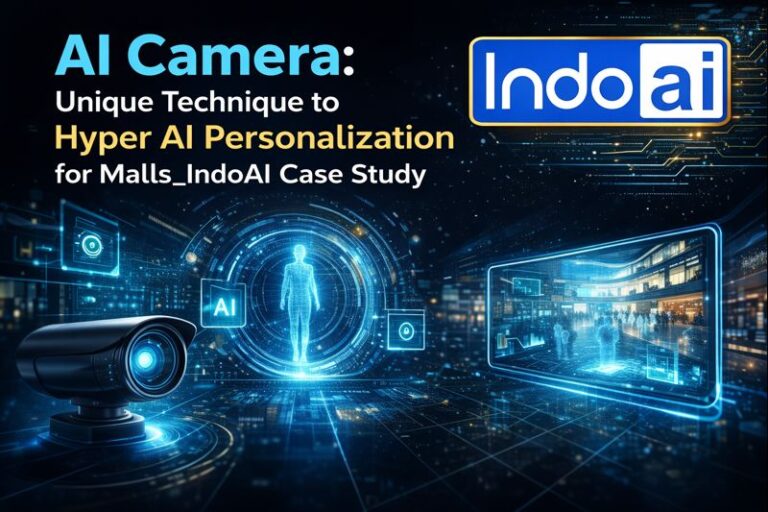
Introduction
With urbanization and large public gatherings on the rise, being aware of crowd dynamics in real time has become a focus of attention for city planners, managers of events or venues, and security personnel (private and municipal). Traditional video surveillance is not effective for estimating crowd numbers, alerting authorities to suspicious behavior or alerting authorities in a timely manner when crowd dynamics change.
Introducing AI camera crowd detection—an advanced technological solution that leverages on‑device artificial intelligence to deliver immediate, reliable insights into crowd density, movement patterns, and safety risks. And IndoAI is helping in this field with the outstanding AI Cameras.
Real‑Time Crowd Monitoring
Urban centers and mass‑gathering venues present a complex array of safety and logistical challenges:
- Public Safety: Overcrowding can result in stampedes, panic, and injuries. Quickly spotting high-density areas helps authorities step in before things get out of hand.
- Operational Efficiency: Event managers and facility operators need precise crowd counts to efficiently plan staffing, concessions, and transportation schedules.
- Regulatory Compliance: Many places enforce limits on crowd sizes at venues like stadiums, concert halls, and religious sites. Not following these rules can lead to fines, losing a license, or even legal trouble.
Conventional camera systems depend on human observation and/or some basic motion-detection algorithms which can create delay, error, and false alarm. AI-based crowd detection cameras process the video source with real-time analytics and no cloud-enabled technology. This maintains privacy while providing a continuous stream of analytics.
How AI Camera Crowd Detection Works
- Image Acquisition: High-resolution and high-frame-rate cameras can be employed to track persons at a real-world location and to count how many people are arriving and departing by their subtle differences of movement.
- On‑Device Inference: These embedded AI models are trained with a variety of datasets consisting of urban scene datasets, concert datasets, and transit center datasets—and perform its video frame processing locally. The models produce accurate crowd counts and flow vectors using methods such as density-map estimation and object clustering.
- Alert Generation: Upon crossing a pre-set threshold (e.g., maximum allowable occupancy or abnormal flow conditions), the camera shares alerts, in real time, to operators through dashboards, apps, or connections to a public address system.
AI camera crowd detection systems keep computation on the edge and avoid the latency of transmission of unprocessed video for cloud-based analytics.
Key Technical Innovations
Creating effective crowd detection solutions requires innovative approaches in model architecture, data management, and system design. Top implementations include:
- Convolutional Neural Networks (CNNs): Modified for density estimation, these CNNs produce a “heat map” prediction over each frame that corresponds to crowd density, enabling reliable counts, even when individual people overlap or occlude each other.
- Temporal Analysis: Beyond simple static counts, recurrent layers or optical-flow modules monitor crowd movement over time, identifying unusual patterns like sudden surges, circular milling, or erratic dispersal.
- Model Compression: Pruning and quantization techniques help shrink model sizes while keeping accuracy intact, allowing for real-time performance on embedded GPUs or specialized AI accelerators.
- Privacy‑By‑Design: Faces aren’t individually recognized or stored. Instead, the models analyze pixel-level density patterns, ensuring they comply with privacy regulations while still providing valuable insights.
Applications Across Industries
AI camera crowd detection finds use in a variety of sectors where situational awareness is critical:
1. Public Events and Entertainment Venues
Crowd management is critical for stadiums, concert venues, and festivals to keep occupancy safe, ease ingress and egress, and minimize congestion in queuing areas. Real time dashboards provide data to security teams to help plan where resources and foot traffic can best be allocated while reducing waiting times and crowding in specific areas.
2. Transportation Hubs
Airports, train stations, and bus terminals use edge-AI cameras to measure passenger flows. Once contactless cameras identify a busy platform or lengthy check-in line, operators can create additional counters, modify train schedules or send alerts to improve transit and customer experience.
3. Smart Cities and Urban Planning
City teams are using tools for crowd analytics to operate urban environments at a Command Center level. AI-enabled cameras provide cities with real-time data, producing pedestrian density heat maps. These heat maps will assist cities in re-timing traffic signals, constructing flow control barriers, and timelier integration with emergency responders prior to arriving at the location.
4. Retail and Shopping Centers
Shopping malls and big box stores leverage crowd detection for staffing assignments, assessing store layout and performance based on foot traffic to improve overall performance of the store, and create refined marketing. For instance, heat maps can be used to show high traffic areas for foot traffic, and when managers utilize heat maps, they can better determine the placement of promotional displays or where to allocate staff.
5. Healthcare Facilities
Hospital and clinics can monitor waiting areas, reduce overcrowding in triage-type areas, and ensure social distancing guidelines are met appropriately. Alerts allow personnel to either open additional waiting rooms, or redirect patients, which improves the quality and safety of service.
Benefits and Business Impact
Implementing AI camera crowd detection delivers measurable returns on investment:
- Enhanced Safety: Early warning of crowding prevents dangerous scenarios, protecting lives and reducing liability exposure.
- Operational Agility: Automated insights free staff from manual headcounts, enabling them to focus on strategic tasks rather than routine monitoring.
- Cost Savings: Edge‑AI architectures minimize cloud infrastructure costs, while lower bandwidth usage reduces network expenses.
- Data‑Driven Decisions: Historical crowd analytics support long‑term planning—whether forecasting footfall trends, scheduling peak‑period staffing, or evaluating the success of promotional events.
Challenges for AI Crowd Detection
Despite its advantages, AI camera crowd detection must navigate several obstacles:
- Variable Lighting and Weather: Outdoor installations may encounter shadows, glare, rain, or fog. Robust preprocessing pipelines and data augmentation during training help models generalize to diverse conditions.
- Occlusions and Dense Crowds: In dense scenarios, individual occlusion can make counting accurately difficult. Multi-angle camera setups can build confidence in counting results, particularly if you can fuse density maps from nearby views.
- Edge Compute Constraints: Firm compression deals with hardware limitations, but it’s clear that some environments need to be even lighter. Finding the correct camera tier with the right amount of CPU, GPU, and memory resources is vital to maintaining a good real-time experience.
- Privacy Concerns: Stakeholders may have concerns about video surveillance. Articulating privacy-by-design practises and having strict data-protection policies, instills public confidence and adherence with legal compliance such as GDPR or India’s Personal Data Protection Act.
Future Trends
- Multi‑Sensor Fusion: Combining data from thermal cameras, LiDAR, or Wi‑Fi signals with visual inputs to achieve greater accuracy in diverse conditions.
- Predictive Analytics: AI models that forecast crowd movements based on historical patterns, enabling proactive resource allocation and pre‑emptive safety measures.
- Edge‑to‑Cloud Orchestration: Dynamic workloads that balance on‑device inference with cloud‑based analytics for aggregated insights across multiple sites.
- Cross‑Domain Integration: Integrating crowd detection with access control, facial‑recognition systems, and environmental sensors to create a holistic smart‑city ecosystem.
Conclusion
AI camera crowd detection is a balance of public safety, operational excellence, and data privacy. By combining on-device intelligence with crowd intelligence, crowd detection systems provide helpful, actionable information on crowd behavior in real time, enabling stakeholders to make informed decisions with the best information in high-stakes spaces. The value of real-time crowd data can be recognized across many environments – stadiums, urban streets, retail space, transportation hubs. The end result of using real-time analytics will be lower incidence of accidents, lower usage of resources, and more data for operational decisions.



